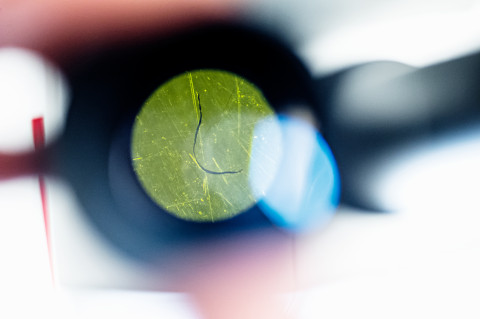The Microscopy Laboratory located on the Kuopio campus has its foundations in the Department of Electron Microscopy, established in the 1970s. The laboratory plays a regionally significant role, particularly in the fields of electron microscopy and imaging spectroscopy, as well as with regard to demanding sample-preparation techniques, particularly for biological samples.
Hard tissue laboratory, providing commercial services also, is capable of processing biological tissues containing metal implants. Also large bone samples can be cut for inspection by an optical microscope.
The SIB Labs Electron Microscopy laboratory is a part of Biocenter Finland, and Biocenter Kuopio infrastructures.

In addition, the SIB Labs Electron Microscopy laboratory is a part of Finnish Advanced Microscopy Node (FiAM) of Euro-BioImaging Finland.
Laboratory services and infrastructure
The Microscopy Laboratory master e.g. electron microscopes (HR-SEM and TEM) and corresponding specimen preparation techniques. The protocols have been developed since the 1970s, and lately in 2010s the infrastructure is modernized by acquiring new microscopes as well as equipment for versatile specimen preparation techniques.
Microscopy
High resolution transmission electron microscope TEM is suitable for analysis of cell, tissue, and plant samples, as well as vesicle and virus samples. TEM has sub-nanometer resolution, STEM-mode, and EDS analyzer for elemental analysis.
Scanning electron microscope SEM has a nanometer resolution and EDS analyzer for elemental analysis. SEM has modern detectors (SE, In-lens, BSE, STEM and VP) for surface examination. 3D reconstruction of surface topology can be made from several SEM images.
Optical microscope enable generating of mosaic images, i.e. full image of large specimens in high resolution.
Transmission electron microscope (TEM)
A modern, high-resolution transmission electron microscope (TEM), was acquired in 2010. Operated either at acceleration voltage of 80 kV or 200 kV, the system is capable of studying biological samples and samples related to materials science at the level of individual atoms. Clinical diagnostics conducted at Kuopio University Hospital, among others, relies on our equipment.
- Model JEM-2100F (Jeol CO, Tokyo, Japan)
- Operating voltage 80 kV or 200kV (field emission)
- Magnification range 50 - 1 500 000 x (transmission mode)
- Resolution < 0.2 nm
- Scanning-transmission accessory
- Digital camera Quemesa 11 MPix (Olympus-SIS, Münster, Germany)
- EDS system Thermo Noran 60 mm2 EDS detector (ThermoFisher, Waltham, USA)
- Sample holders: Routine, multi-sample, high-hilt
Scanning electron microscope (SEM)
- Model SIGMA-HD|VP (Carl Zeiss NTS, Cambridge, UK)
- Operating voltage 0.02 – 30 kV (field emission)
- Magnification range 30 - 500 000 x
- Resolution < 2 nm
- Scanning-transmission mode
- SE2, InLensSE, VP-SE, BSE, Stereoimaging 3D
- 2 x EDS: Thermo 60 mm2 EDS SDD-detectors (ThermoFisher, Waltham, USA)
- Sample holders: 9 sample carousel, a carousel for 1” filters (5 samples), a holder for 12 TEM grids, and a screw clamp

Carl Zeiss AxioImager M2 is a motorised optical microscope. It has 1.25x, 2.5x, 5x, 10x, 20x, 40x, 50x and 100x objectives, fluorescence equipment (UV, FITC, GFP and Rhodamine), and incident-light for non-transparent samples. Motorized stage enables e.g. full imaging of large specimens in high resolution.
- Nikon TE-300; Inverted microscope (currently no camera attached)
- Nikon Microphot FXA; optical microscope including DIC and phase contrast optics, among others (currently optimized for densitometry)
- Zeiss Primo Star + AxioCam ERc 5s color camera (for lab use) with 4x, 10x, 40x ja 100x (oil) objectives
- Stereo microscopes (Carl Zeiss, Leica); for inspecting large samples
- Leica MZ75 with Nikon DS-Fi2 color camera + DS-L3 control unit
- Zeiss Stemi DV4
- Biacore X; surface plasmon resonance spectrometer for studying the bindings of biomolecules

Elemental analysis
- Equipped with energy dispersive X-ray spectroscopy (EDS), electron microscopy can be used to study elemental composition of the specimens at the same time with EM imaging. We have developed intrumentation and analysis methods especially for biological specimens.

Tomography
- In TEM we have the possibility to carry out electron tomography (ET) studies.
ET can be applied to study 3D structures even in nanometer scale. - A series of images with changing tilt angle is captured during imaging and afterwards, 3D tomogram is reconstructed and analyzed.

Surface structures
Samples for SEM need typically to be dry and conductive. Therefore, biological specimens are fixated, dehydrated and coated with thin layer of metal. Small specimens are dehydrated chemically, via ascending concentration series of alcohol and hexamethyldisilazane (HDMS). Larger specimens can be dried using a critical point drying (CPD) instrument. In either case, water within the specimen is substituted with a solvent with lower surface tension that helps keeping the specimen structure intact. Our new SEM (Zeiss Sigma HD|VP) has maximum resolution of about 1 nm.
However, also non-conductive specimens can be imaged with appropriate instrumentation and detection (so-called variable pressure mode), or even moist samples can be analyzed.
Surface 3D
In addition to conventional secondary electron imaging, 3D reconstruction of the sample surfaces can be processed from data acquired with four-quadrant backscatter electron detector. At best, surface roughness and volumetric analysis is applicable.

Elemental analysis
Similarly to TEM, elemental composition can be analyzed at the same time with SEM imaging. However, SEM is especially useful to analyze elemental distribution (i.e. elemental mapping) in the sample. Keep in mind that typically the elemental information is collected from about 1 micrometer deep layer.

Scanning-transmission mode
TEM grids can be inserted and analyzed with SEM, too! If low magnification is sufficient and you are more familiar to SEM than to TEM, you may use SEM for transmission imaging.
Correlative microscopy (CLEM)
Together with PhD Kirsi Rilla from the Institute of Biomedicine we have developed protocols to study first live cells with confocal microscopy, and later the very same cells with SEM.
Sample preparations
In the sample-preparation laboratory for electron microscopy samples are processed in accordance with the protocols agreed with customers (researchers or companies). Ultra-thin (approximately 70 nm) cross-sections for inspection by TEM or, for example, dried and gold-coated samples for SEM inspection, are prepared. During years 2014-2015 special equipment for processing of challenging specimens from the material science was acquired. Based on ion bombardment, these equipments can be used to prepare, e.g. cross-sections of multi-layer coatings or pharmaceutical materials for SEM or TEM analysis.
Sample preparation equipments
-
Leica Ultracut UC; Ultramicrotome
-
Reichert-Jung Ultracut E; Ultramicrotome. Accessories Cryo device (FC 4E; Reichert-Jung, Austria) ja Cryo fixation device (KF 80; Reichert-Jung, Austria)
-
Reichert-Jung Lynx EM Tissue Processor; Tissue automaton for EM samples
-
Reichert-Jung Ultratrim; Trimming device
-
Leica Ultrostainer; Staining automaton
-
Reichert AFS; Heat exchanger device
-
Quorum Technologies K850; Critical point drying
-
Leica EM RES102; Ion bombing device for EM sample prosessing
-
Leica EM TXP; Pretreatment of EM samples by sawing and grinding
-
Leica EM ACE600; For finishing of electric conductivity of EM samples
-
Agar Scientific Automatic Sputter Coater B7341
-
LKB Knife Maker 7801 B
-
ZEISS Primo Star; A light microscope with a camera

Plastic embedding and thin sectioning
Conventional sample processing for transmission electron microscopy includes fixation with e.g. 2-2.5 % glutaraldehyde in 0.1 M phosphate buffer, post-fixation with osmium tetroxide, dehydration in ascending concentration series of alcohol, and embedding in plastic resin (Epon). Ultramicrotome is used to cut ultrathin sections (about 70 nm) that are finally post-stained (contrasted) with uranyl acetate and lead citrate.
Freeze Substitution (FS)
With the aim of avoiding artefacts caused by chemical fixation, the specimens can be fixed by using rapid freezing. After freezing, the process is followed by freeze-substitution (FS) meaning that water within the specimen is substituted with organic solvent at low temperature (less than -70°C) and embedded in plastic or processed for IEM. Our aim is to develop this methodology.
Negative Staining
This method is typically used to study e.g. isolated organelles, particles or viruses. In practice, a droplet of biological micro-organism is incubated on a carbon-coated and glow-discharged TEM grid. Excess sample is removed and rinsed, contrasted using heavy element salts (e.g. uranyl acetate). Also immunostaining is applicable for the specimens.
Finland´s only hard tissue laboratory providing commercial services is capable of processing biological tissues containing metal implants. Also large bone samples can be cut for inspection by an optical microscope.
Applications of hard tissue methods can be related, for example, to biotechnology, health- or material technology, or biopsies, implants, teeth, vascular stents, multilayer electronics or surface treatment of materials. Also wood or forest companies may benefit from hard tissue laboratory methods.
Sample preparation equipments
- Macro Exakt 310 CP: Sawing hardware with diamond cutter and automatic alignment.
- Exakt 400 CS: Micro-grinding hardware with AW 110 and 40 CS accessories.
- Reichert-Jung Polycut S: Hard tissue microtome for bone and cartilage samples.
- Leica MZ 7-5: Stereomicroscope with Nikon Digital Sight DS-Fi2 camera.
Exakt hardware system for sample processing:
- Exakt 510 with dehydration and infiltration systems
- Exakt 520 light polymerization device
- Exakt 530 post processing system with hotplate, light, vacuum, and polymerization device
- Exakt 401 adhesive press
- Exakt 402 precision adhesive press

Saw cut and grinding
Saw cut and grinding are suitable for tissues containing implants, teeth and other hard samples. For light microscopy up to 20 micrometer grinded slices can be prepared. Also preliminary treatment of SEM samples can be made by saw cut and grinding.

Sectioning with microtome
Sectioning with a microtome is suitable for cartilage and bone tissues. For light microscopy up to 3 micrometer slices, and for IR microscopy 3-5 micrometer slices can be prepared.





